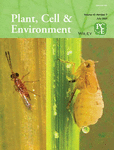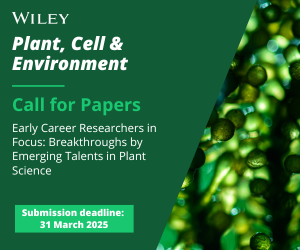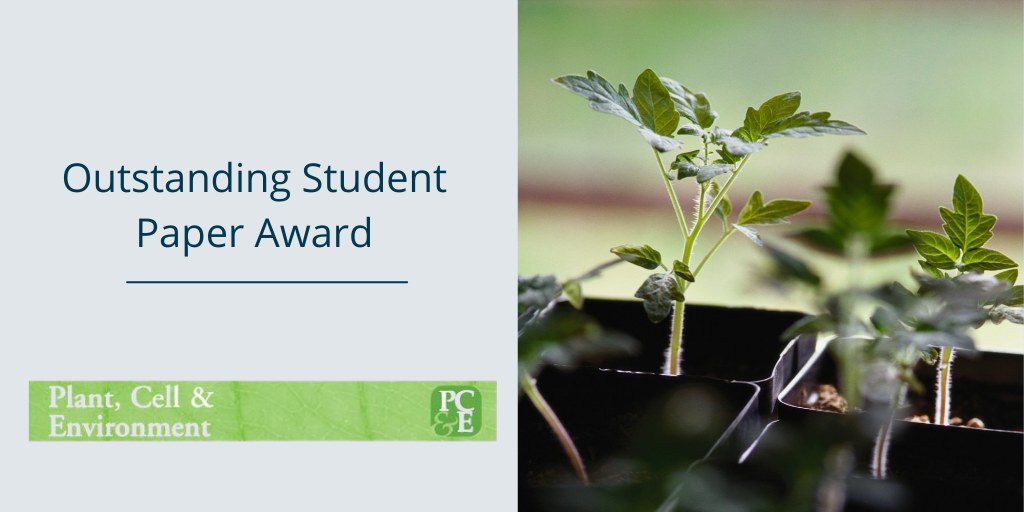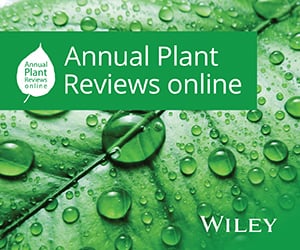Journal list menu
Export Citations
Download PDFs
COVER IMAGE
Host plants alter their volatiles to help a solitary egg parasitoid distinguish habitats with parasitized hosts from those without
- Page: i
- First Published: 26 June 2020
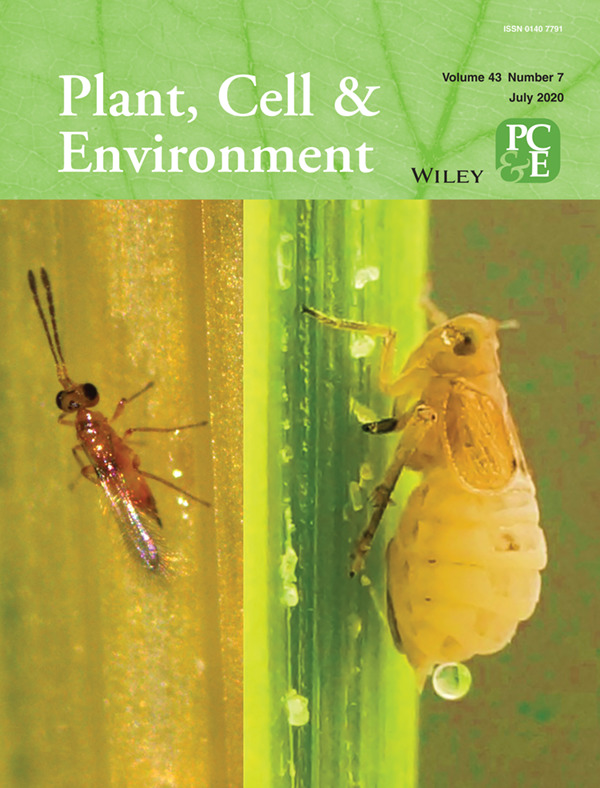
The cover image is based on the Original Article Host plants alter their volatiles to help a solitary egg parasitoid distinguish habitats with parasitized hosts from those without by Cheng-Zhe Li et al., https://doi.org/10.1111/pce.13747.
ISSUE INFORMATION
REVIEW
Rice yield formation under high day and night temperatures—A prerequisite to ensure future food security
- Pages: 1595-1608
- First Published: 28 February 2020
In this review article we highlighted the phenological implications of heat stress and summarized the molecular physiological implications affecting HDT, HNT, and HDNT tolerance with a holistic approach of physiology, genomics, and systems-genetics approaches. We outlined future breeding strategies to address sustained food security under climate change.
COMMENTARY
At the crossroads of strigolactones and abscisic acid pathways: A role for miR156
- Pages: 1609-1612
- First Published: 14 May 2020
This article comments on: A novel strigolactone-miR156 module controls stomatal behaviour during drought recovery
ORIGINAL ARTICLES
A novel strigolactone-miR156 module controls stomatal behaviour during drought recovery
- Pages: 1613-1624
- First Published: 20 March 2020
Strigolactones are phytohormones important for effective drought responses, and miR156 is a conserved microRNA induced by environmental stress. This work identifies strigolactones as triggers of miR156 induction under drought in tomato. It also correlates miR156 with the strigolactone- and ABA-dependent promotion of sustained stomatal closure after rewatering. Thus, a novel strigolactone-miR156-ABA module is uncovered that is important for the stomatal memory of drought.
Shade avoidance responses become more aggressive in warm environments
- Pages: 1625-1636
- First Published: 10 January 2020
We obtained laboratory and field data and generated a model that estimates hypocotyl growth rate as a function of light and temperature conditions with reasonable accuracy. By using this model in combination with worldwide climate data, we predict enhanced shade avoidance responses as temperature rises.
Dynamics of sun-induced chlorophyll fluorescence and reflectance to detect stress-induced variations in canopy photosynthesis
- Pages: 1637-1654
- First Published: 13 March 2020
Passive measurement of sun-induced chlorophyll fluorescence is a promising tool to quantify stress-induced changes in photosynthetic functioning on a large scale. In this study, aerial measurements of fluorescence clearly tracked functional impairment of the rate of photosynthetic electron transport and carbon assimilation induced by a treatment with the herbicide Dicuran. Ancillary remote sensing variables such as vegetation indices and canopy temperature were used to quantify the dynamics of non-photochemical energy dissipation mechanisms, the amount and composition of photosynthetic pigments and the stomatal activity. These results demonstrate the potential of using sun-induced chlorophyll fluorescence coupled with relevant reflectance indices to estimate stress-induced changes in canopy photosynthesis.
Exogenous strigolactones impact metabolic profiles and phosphate starvation signalling in roots
- Pages: 1655-1668
- First Published: 29 March 2020
The current work provides evidences supporting that the phytohormone strigolactones are early modulators of plant responses to low Pi availability and that they impact metabolic profiles in the roots. This knowledge may help to develop new strategies to optimize plant Pi acquisition efficiency and use.
OsSQD1 at the crossroads of phosphate and sulfur metabolism affects plant morphology and lipid composition in response to phosphate deprivation
- Pages: 1669-1690
- First Published: 08 April 2020
The mutation in OsSQD1 affected several morphophysiological and molecular traits governing homeostasis of Pi, S and lipid composition in the whole plant. The positive influence of OsSQD1 was also evident on the developmental responses of different root and reproductive traits under different Pi regime. The study thus highlighted a broad spectrum role of OsSQD1 in Pi and S homeostasis, and lipid composition in response to Pi deprivation.
LaALMT1 mediates malate release from phosphorus-deficient white lupin root tips and metal root to shoot translocation
- Pages: 1691-1706
- First Published: 02 April 2020
White lupin (Lupinus albus) is recognized for its outstanding phosphate mobilization from phosphorus-deficient soils with cluster roots via organic acid anion release. A root tip-localized ALMT protein (from the family of aluminium activated malate transporters) specifically releases malate under P-deficiency from clusters to mobilize phosphate, independent of aluminium. In addition, LaALMT1 also participates in root to shoot translocation of metals, such as iron.
Root high-affinity K+ and Cs+ uptake and plant fertility in tomato plants are dependent on the activity of the high-affinity K+ transporter SlHAK5
- Pages: 1707-1721
- First Published: 10 April 2020
The K+ transporter SlHAK5 from tomato plays a crucial role in K+ nutrition, in particular under saline conditions, and in the accumulation of Cs+ in vegetative tissues and in fruits. Moreover, slhak5 fruits have few seeds which are related to SlHAK5 contribution to pollen K+ uptake and viability.
The res (restored cell structure by salinity) tomato mutant reveals the role of the DEAD-box RNA helicase SlDEAD39 in plant development and salt response
- Pages: 1722-1739
- First Published: 23 April 2020
The role in plant development and fruit yield of a chloroplast-targeted tomato (Solanum lycopersicum) DEAD-box RNA helicase, SlDEAD39, is described. We propose that other DEAD-box RHs might be partially redundant to SlDEAD39, mediating their specific functions in salt stress response.
Host plants alter their volatiles to help a solitary egg parasitoid distinguish habitats with parasitized hosts from those without
- Pages: 1740-1750
- First Published: 14 March 2020
We demonstrate that the parasitism of the brown planthopper (BPH) eggs by Anagrus nilaparvatae increased levels of four volatile chemicals emitted from BPH gravid female-infested rice plants, and these increased volatiles decreased the attractiveness of the host plant to the conspecific parasitoid. Our results suggest that host plants can alter their volatiles to help egg parasitoids discriminate host habitats with parasitized hosts from those without parasitized hosts.
Stem emissions of monoterpenes, acetaldehyde and methanol from Scots pine (Pinus sylvestris L.) affected by tree–water relations and cambial growth
- Pages: 1751-1765
- First Published: 26 April 2020
Scots pine (Pinus sylvestris L.) stems are a considerable source of monoterpenes, methanol and acetaldehyde. Their emissions depend strongly on temperature, but the temperature-normalized emissions are affected by relatively small changes in soil moisture and cambial growth of stem.
Terpenoids are transported in the xylem sap of Norway spruce
- Pages: 1766-1778
- First Published: 08 April 2020
We identified a considerable amount of terpenoids in the xylem sap of Norway spruce trees. Four of them were identified only in xylem sap and emissions, but not within needle tissue, suggesting that emission of these compounds is likely driven from xylem sap contents.
Association genetics identifies a specifically regulated Norway spruce laccase gene, PaLAC5, linked to Heterobasidion parviporum resistance
- Pages: 1779-1791
- First Published: 10 April 2020
Heterobasidion parviporum is a major pathogen of Norway spruce in Europe. This study identified 11 Norway spruce QTLs for resistance to H. parviporum. One of the QTLs comprise the laccase PaLAC5 and expression analyses suggest that PaLAC5 may be associated with the lignosuberized boundary zone formation.
The Arabidopsis CCCH protein C3H14 contributes to basal defense against Botrytis cinerea mainly through the WRKY33-dependent pathway
- Pages: 1792-1806
- First Published: 12 April 2020
Plant CCCH proteins play diverse roles in growth and stress responses, but the regulatory mechanism of CCCH proteins in plant immunity remains unclear. We here demonstrate that the Arabidopsis CCCH protein C3H14 positively regulates basal resistance against B. cinerea mainly by the WRKY33 defense pathway. The C3H14-WRKY33 cascade triggers plant immunity by mediating JA/ET signaling and promoting camalexin biosynthesis.
CORRIGENDUM
“A regulatory role of autophagy for resetting the memory of heat stress in plants”
- Pages: 1807-1809
- First Published: 26 June 2020




